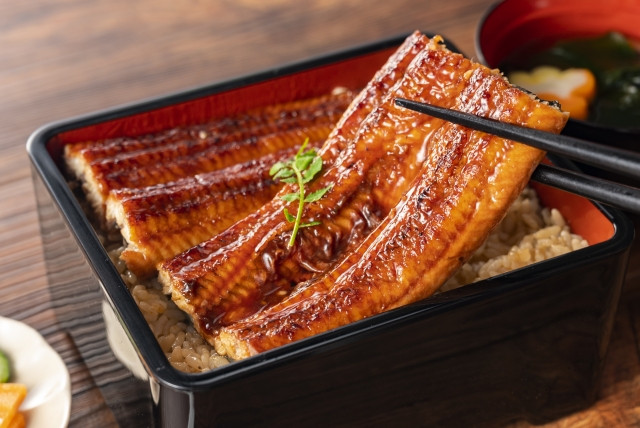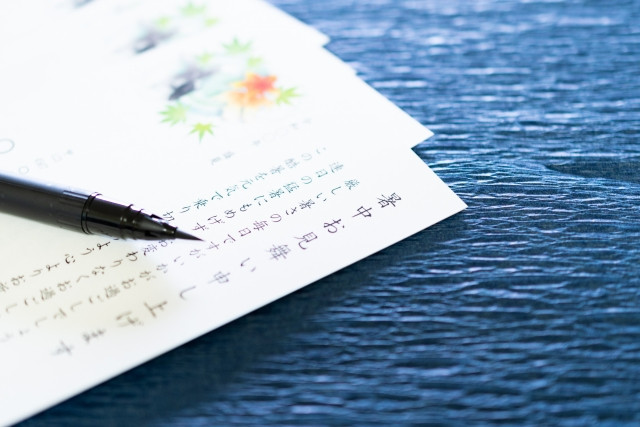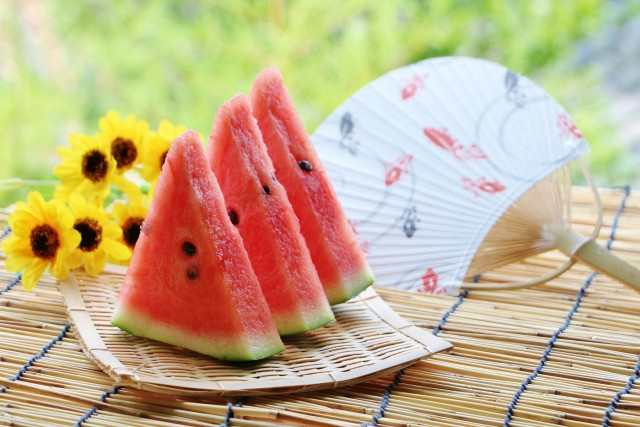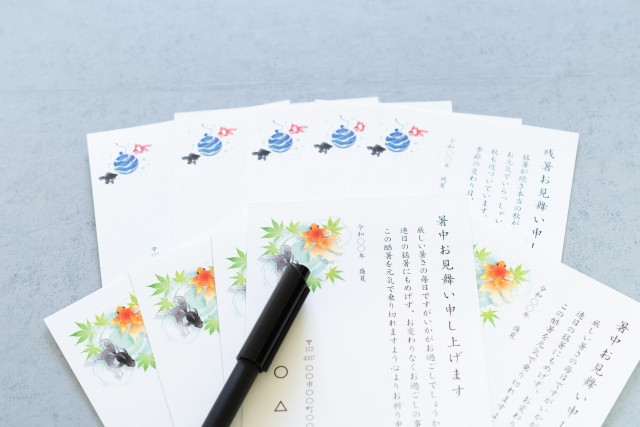Shochuu Mimai (暑中見舞い) is the traditional Japanese custom of sending greeting cards and gifts to people during summer. Learn about the shochuu mimai culture and draw a picture of Japan’s summer scenery.
Table of Contents
- What is 暑中見舞い (Shochuu Mimai)?
- Origin of Japan’s Custom of Sending Greeting Cards in Summer
- How to Write a Summer Japanese Greeting Card
- 中元 (Chuugen): Japanese Summer Gift Culture
What is 暑中見舞い (Shochuu Mimai)?

暑中見舞い (Shochuu Mimai) are summer greeting cards and gifts sent to inquire after someone’s health during Japan’s hottest season. The breakdown of the Kanji is as follows:
- 暑中 (Shochuu) meaning the “height of summer”, the “hottest part of summer”
- 暑 (Sho) meaning “heat” or “midsummer”
- 中 (Chuu) meaning “in the middle of”
- 見舞い (Mimai) meaning “inquiry about someone’s health” , also used to mean “to visit someone who is sick”
It is common to send summer greetings and even gifts to family, friends, colleagues, and business partners to express concern for their well-being during the hot summer months. It is a gesture of goodwill and thoughtfulness, expressing your wish to check in on others and share summer wishes.
When is 暑中 (Shochuu), the hottest part of summer?

The period of 暑中 (Shochuu) refers to the hottest time of the year. When is this period? There are no exact dates, but it is said to start from “夏の土用 (Natsu no Doyou) - Midsummer”.
“夏の土用 (Natsu no Doyou)” is from a solar term from the traditional Japanese microseason calendar that breaks down the year into seasonal events. 夏の土用 (Natsu no Doyou) is 18 days before “立秋 (Rishuu) - the beginning of autumn”, or around 1 month from “小暑 (Shoshou) - minor heat”. When converted to the modern Gregorian calendar, 暑中 (Shochuu), or midsummer, isi the period from early July to early August.
What is 土用 (Doyou)?

土用 (Doyou) occurs 4 times a year for each season in Japan. It refers to the 18 days before the “beginning of spring (立春, Risshun)”, the “beginning of summer (立夏, Rikka)”, the “beginning of autumn (立秋, Rishuu)”,and the “beginning of winter (立冬, Rittou)”.
The most famous among them is “夏の土用 (Natsu no Doyou)”. The zodiac day associated with this day is the Day of the Ox, called “丑の日 (Ushi no Hi)”. It is also commonly written as “土用の丑の日 (Doyou no Ushi no Hi)”, or “Midsummer’s Day of the Ox. It is a day to rejuvenate one’s health for the summer by eating nutritious unagi.
What is 残暑見舞い (Zansho Mimai)?
A summer Japanese greeting card sent after midsummer is called 残暑見舞い (Zansho Mimai), or “late summer greeting card”. 残暑 (Zansho) means “remaining heat”, referring to the leftover heat from summer that crosses into autumn.
A simple way to understand is, if 暑中見舞い (Shochuu Mimai) is “How are you doing this hot summer?”, then 残暑見舞い (Zansho Mimai) is “Hope you were well through the summer heat”.
Writer's Pick
Origin of Japan’s Custom of Sending Greeting Cards in Summer
Shochu Mimai is characterised by sending “暑中見舞いはがき (Shochu Mimai Hagaki), or “Shochuu Mimai postcards”.
It is similar to Japan’s custom of sending New Year greeting cards in the form of postcards, which is also a long-established tradition in Japan, the point that post offices issue special postcards. It is said that the first Japanese summer greeting postcard was issued in 1950, and postcards with lottery numbers (くじ, Kuji) printed on them have been issued since 1986.
The origins of Shochu Mimai are said to date back to the Edo period. Traditionally, during Obon (お盆), people returned to their hometowns bearing gifts as offerings for their ancestors. Entering the Edo period, this expanded to include greetings and gifts for people for whom they were indebted. When it was not possible to visit in person, gifts and letters were sent through couriers.
This practice evolved with the establishment of a developed postal system in the 6th year of the Meiji era, making it easier to send mail and packages. By the Taisho period, this had developed into the modern day Shochuu Mimai culture.
※ Japan Post, “暑中・残暑見舞いのマナー”
How to Write a Summer Japanese Greeting Card

Shochuu Mimai are sent to “people who you rarely meet (family back in hometown, relatives, friends), people who you are indebted to, or people who are indebted to you”, according to Japan Post.
To put it simply, Shochuu Mimai is fine to send to “people who you want to meet” or “people who you are thankful for”.
How to Write Shochuu Mimai
Shochuu Mimai are divided into 4 parts:
- お見舞いの挨拶 (Omimai no Aisatsu): The summer greeting that is usually this set phrase, “暑中お見舞い申し上げます (Shochuu Omimai moushiagemasu)”. As the main greeting, it is recommended to write stylishly, and larger than the remaining parts of the greeting card. No punctuation so it looks elegant.
- 主分 (Omobun): The main text. Start with casually talking about the summer climate before inquiring about the person’s well-being. Freely write to your heart’s content asking about summer plans, work, or personal matters.
- 結びの挨拶 (Musubi no Aisatsu): The closing greeting. Wishes for the recipient’s good health for the summer is recommended. A common expression used is “夏バテなどなさいませんよう (natsubate nado nasaimasen you”. It is a summer wish that expresses concern for the recipient and means, “Please take care not to get summer fatigue”.
- 日付 (Hizuke): The date. It is not necessary to write a specific date. You can end with something like “令和6年 盛夏” hat translates to “Summer 2024”.
Words that are Good to Know
- 夏バテ (Natsubate) meaning “summer fatigue”
- 夏の便り (Natsu no Tayori) usually refers to “shochuu mimai”, 便り(Tayori) means “letter”, so it directly translates to “summer letter”
- 中元 (Chuugen) meaning “summer gift”
中元 (Chuugen): Japanese Summer Gift Culture

暑中見舞い (Shochuu Mimai) are mainly postcards or letters, but there is also the culture of 中元 (Chuugen), which is sending summer gifts to people you are grateful for. Although there are differences in the period of time to send summer gifts, it is broadly divided into either early July to mid-July or mid-July to mid-August.
There is no specific type of gift you should give but popular items include summer fruits such as melons, watermelons, peaches and mangoes. Other popular gifts are snacks, noodles such as soba, and drinks.

Supermarkets and department stores start to offer summer gift services from May. It is a convenient method to send Chuugen as you can pick from a list of available gifts and they will have it delivered for you. The service is also offered at post offices.
When sending Chuugen, it is customary to send a card with a personal message. The contents of the card are similar to the postcard. The extra effort of sending a gift further expresses your concern and care for the recipient during the hot summer months.
To Close

暑中見舞い (Shochuu Mimai) and 中元 (Chuugen) are Japanese greeting cards and gifts sent during the hot summer months in Japan. They express concern and well wishes to someone you care about. Are you sending a Japanese greeting card or gift to anyone this summer?
Read more about Gift Giving in Japan and Sending Greeting Cards which are long-time traditions in Japan.












.jpg)





.png)


















